I’m Mike, and I don’t like a scrotum dangling over my face when I’m bench pressing.
Or a sweaty hardo snuggling with me while I squat.
Or shrieking at me to “dig deep,” “feel the burn,” or “let the big dogs eat.”
You see, after 18 years of gymming, I’ve experienced a lot of bad spotting, and most people seem to have no idea how to do it correctly.
It’s too bad, too, because good spotting can make a difference in your training.
For example, it can encourage you to go for that extra rep when you have a few hundred pounds on your back and your legs are on fire.
A good spotter won’t make those grinders any easier, but at least you know you won’t split your kneecaps in half like communion wafers.
Another benefit of good spotting is, often, just having someone there can mysteriously increase your strength.
It sounds dippy until you experience it yourself.
You’re deep in a set, and the bar is getting heavier by the second. Then, your buddy puts his fingers under it, and suddenly, you’re filled with a second wind and shoot the weight up.
Sorcery, I tell you.
So, how do you spot well?
It isn’t rocket surgery. You basically stand there and make sure the spottee doesn’t maim or decapitate themselves.
Most of the time, it only takes a nudge. If spotting were indeed surgery, it’d require a scalpel, not a truckload of Juggalos with chainsaws.
My point:
The key to good spotting isn’t making the entire set easier, it’s just ensuring your buddy doesn’t gank himself.
You’re not needed most of the time, so you let them huff and puff and grunt and groan as they cross swords with mean ol’ Mr. Gravity.
That means that spotting the bench press isn’t an invitation to do some curls. Spotting a squat shouldn’t look like tandem skydiving.
The general rule of spotting is this:
If the weight’s moving up, even if slowly, don’t help.
And by “don’t help,” I mean don’t touch them or the bar unless you’re absolutely needed. Make them fight it out.
Then, when it’s time to step in—when the weight is stuck or slipping backward—do it right.
Lift the weight forcefully if they’re gassed, otherwise, take just enough load off for them to finish the rep. Spot the wrists on a dumbbells press. Spot the lifter on the squat.
That’s it, really.
Want to listen to more stuff like this? Check out my podcast!
Smother-Spotting
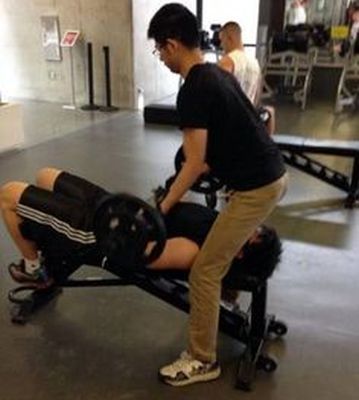
Why do some people just love being too fucking close to others?
When they talk to you, they want to be a foot from your face.
When they stroll with you, they basically shoulder you off the sidewalk.
And when they spot you, you feel at least some part of their bodies rubbing against yours at all times.
It’s like they don’t realize that asking for a spot on the bench press isn’t code for “can you dangle your nuts over my forehead?”
Or that spotting a squat and daggering have absolutely nothing in common.
The point is it’s supposed to be a spot, not a cuddle or pat-down.
Underspotting
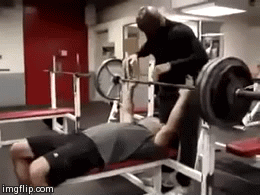
“Don’t touch the FUCKING bar.”
That’s what this dude said to me as my hands moved into place while he wavered on his first rep of 315 on the military press.
If I complied, I’m pretty sure he would have died.
I waited for the bar to officially stop moving and…didn’t let him die.
My point is this:
Most guys ask for a spot because they’ve put up way more weight than they can actually lift.
How many times have you seen someone with so many plates on the bar that he can only be a powerlifting phenom or complete idiot?
And then, before they even finish the first rep, you quickly realize their frail little bodies are in your hands?
Well, that’s when you have to remember…
Your job is to keep the bar moving, not to scream obscenities while their lives are flashing before their eyes.
Yes, it’s true that having to do much at all as a spotter means there’s probably too much weight on the bar.
Sometimes you just have to save people from themselves, though, calmly listen to how they “almost got it,” and walk away.
Not Paying Attention
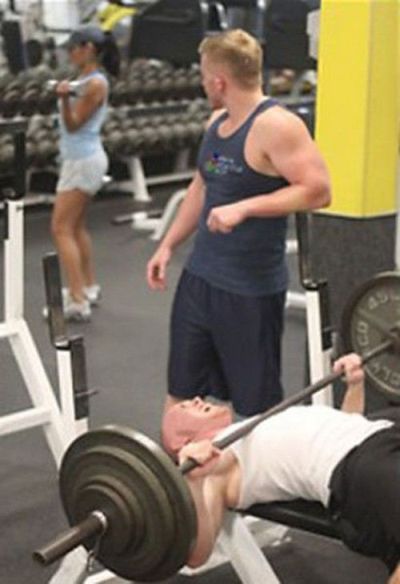
I used to work out with a guy that had the distractibility of a toddler on bath salts.
It was (almost) impressive.
I don’t know how many times I about shit myself finishing my set, only to find him oogling at some girl or simply staring off into space.
It’s very simple. When someone asks for a spot, he’s not asking for much:
30 seconds of your undivided attention.
No Facebook. No Instagram. No Tinder. For 30 seconds. For fuck’s sake.
Giving Shitty Advice…Spotting
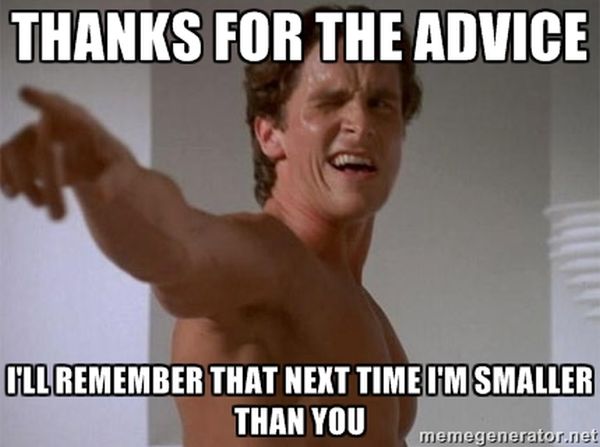
“Your back is too far forward when you squat.”
“You’re bringing the bar down too far on your bench press.”
“You’re resting too much in between sets.”
“Why are you lifting so heavy? Muscles don’t know weight, they only know tension.”
Every gym has at least one clueless asshole that won’t stop telling people how to work out.
He watched this YouTube video once and now he’s on a mission to bring his wisdom to the plebs.
And if you’re unlucky enough to get him spotting you, he’s not going to shut up.
You don’t come to his office and knock the cocks out of his mouth. Why won’t he just leave you alone?
Well, you don’t have to get rude or argumentative. A few simple, non-confrontational ways of making him go away:
- “I appreciate the help but I’m just following what my coach/trainer has laid out for me.”
- “Thanks for the tips but I’d like to just do my workouts.”
- “I know you’re just trying to help but I’d appreciate it if you let me just do my workouts.”
The lesson here is it’s bad gym etiquette to give workout advice to strangers unless they ask for help.
When people ask for a spot, they just want, gasp, a spot, not a lecture.
How to Be a Good Spotter
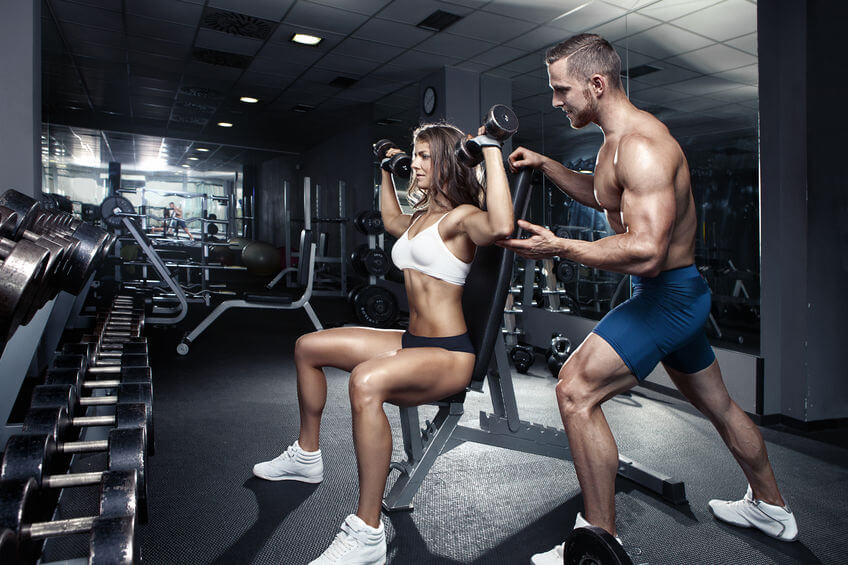
The first step to being a good spotter is knowing that you’re not needed most of the time.
That is, most exercises don’t benefit from spotting, and even those that do can be performed safely without assistance.
For example, while it’s comforting to bench press with a spotter, you can bench press solo safely…
That said, lifting with a spotter does have its advantages.
- It allows you to go for that extra rep that you might not want to try otherwise.
You don’t need to train to absolute failure every set, but you need to come close most of the time.
And that can be scary when you have a few hundred pounds on your back and your legs are on fire.
A spotter isn’t going to make those last reps any easier, but at least you know you’re not going to wake up in the hospital.
- Just having someone there to assist can strangely increase your strength.
I mentioned this earlier and it sounds ridiculous until you experience it for yourself:
You’re struggling on your last rep, the bar is getting exponentially heavier by the second, and your buddy puts his fingers under it.
Suddenly, your muscles tap into some hidden power reserve and you shoot the weight up.
The main thing you need to know to be a good spotter is that you’re there for safety reasons only.
The general rule is this:
If the person you’re spotting is keeping the weight moving up, even if slowly, don’t help.
And by “don’t help,” I mean don’t touch him or the bar unless you’re absolutely needed. Let him struggle against the weight.
Now, when it’s time to step in, it’s important to do it right.
Let’s break this down by the major exercises that you’ll be spotting.
How to Spot the Bench Press
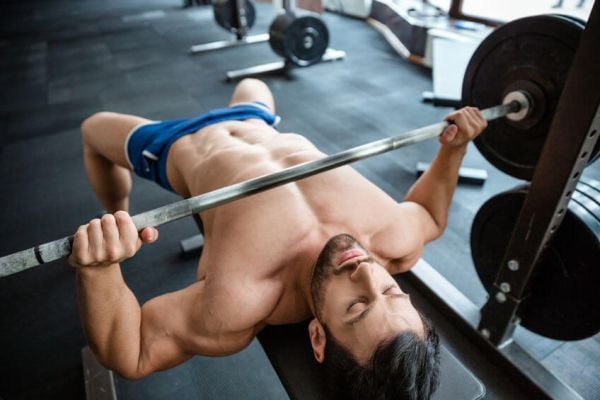
As you know, you can safely bench press without a spotter if you have a proper rack setup.
If you don’t, or if you just want a spotter there to help get you through the last rep or two, let’s look at how it’s done.
1. Ask how the person is going to do his set.
How many reps is he going for? Anything fancy like negatives or forced reps?
2. Set up behind him, like this:
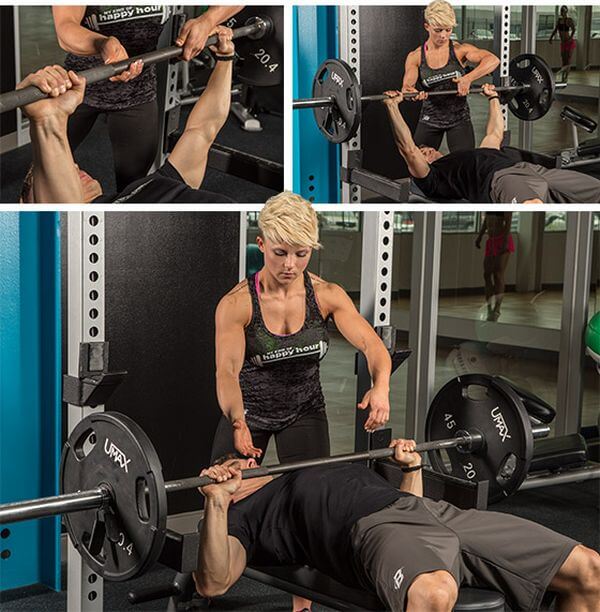
This position keeps your crotch at a comfortable distance from his face.
Also, wipe the sweat off your face so you don’t dribble into his mouth (yup, it has happened to me).
3. Ask if he needs help with the lift off.
4. Let him do as many reps as possible without any assistance from you.
Keep your hands near the bar, but don’t touch it.
5. If at any point, the bar starts moving in the wrong direction, or if he asks for your help, use full force to help him finish the rep.
This is where many people accidentally underspot by only partially alleviating the load.
If the bar is moving backward, or if he cries uncle, the set is done.
6. If the bar has stopped moving up, bring your index fingers (or palms) in under it but don’t take any weight off yet.
Just putting them against the bar is often provides the boost needed to finish the set.
7. If the bar still isn’t moving, grab it with your hands and take about 10 percent of the load off.
Remember, you want him to struggle to finish the rep.
Your goal is to take just enough weight off so he can grind the rep out.
8. If he’s still stuck, take another 10 to 15 percent of the load off.
9. If he’s still stuck, he’s toast–take as much of the load off as you can so he can finish the rep.
That’s it. Mostly just common sense, as you can see.
This, by the way, is also how you spot a military press.
How to Spot the Dumbbell Press

All the above applies to spotting the dumbbell press, but the key difference is with dumbbells, you spot the elbows.
Here’s how it looks:
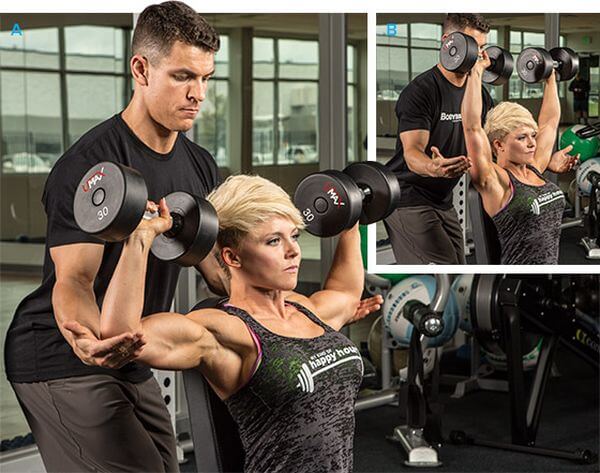
As with barbell spotting, you don’t want to actually touch the person’s elbows unless he’s stuck, and you don’t want to help more than necessary when he does get stuck.
Another important point with dumbbell spotting is you want to push the weight straight up, not forward or in toward his body.
I should note, though, when heavyweights are involved, it can be safer to spot at the wrists because if he fails and you’re at the elbows, one of the dumbbells can come down on his face.
The lifter may also ask for help getting the dumbbells into position to start the set.
You do this by handing him each dumbbell one at a time, using both hands on the weights (leaving the handles free for him to grab).
This is also how you help him put the weights down after the set is complete (if necessary).
How to Spot the Squat

The only major difference here is you want to spot the lifter, not the bar.
You do this by placing your arms under the lifter’s, ready to hook across his chest, like in the image above.
The reason for hooking across the chest is it allows you to simultaneously take weight off and help the lifter maintain proper form.
(As we get fatigued in the squat, we tend to collapse forward, which places the back in a compromised position.)
As usual, don’t make contact unless you’re needed. Simply “shadow” him in his reps, staying out the way.
Also, make sure you’re in place as he unracks the bar and stay in place until it’s racked.
The Bottom Line on Spotting
Spotting is one of those “little” things that can make quite a difference in the overall quality and effectiveness of your workouts.
Bad spotting can make for bad workouts and good spotting can help you build muscle and strength faster.
So spot well, get spotted well, and make the gym a better place.











